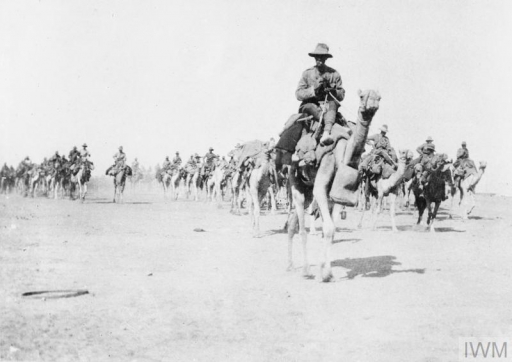Major Paul Knight discusses the upturn in fortunes for the Allied campaign in Sinai in autumn 1917 after Sir Edmund Allenby replaced Sir Archibald Murray as Commander-in-Chief. Defeating the Ottomans at Beersheba in October opened the way to Palestine.
General Murray’s two failed Battles of Gaza in the spring of 1917 meant the year did not start particularly well for the Allies in the Middle East. But following the victory under new leadership at Beersheeba on 31 October, 1917 would end with the fall of Jerusalem.
Even the choice of replacement for Murray could have backfired, for Allenby, not unreasonably, saw his appointment to command the Egyptian Expeditionary Force (EEF) as a demotion to a sideshow after the Western Front. In 1914, he had led the British Expeditionary Force’s Cavalry Division, rising through corps command to Third Army in October 1915.
However, Allenby had come into conflict with Sir Douglas Haig, British Commander-in-Chief on the Western Front, following his performance at Gommecourt on the Somme in 1916, and the missed opportunities at Arras in 1917. It would take Prime Minister David Lloyd George’s not inconsiderable charm to convince him of the opportunities in the Middle East – as a result, Edmund Allenby is probably the only British general remembered as a success in the Great War. Yet even his arrival in Egypt in June 1917 was overshadowed by the news of the death of his 19-year-old son, Christopher, a lieutenant with the Royal Horse Artillery.
Logistics
Allenby set about rebuilding the EEF during the summer of 1917, much as General Sir Frederick Maude had done in Mesopotamia the previous summer. Both commanders understood the significance of logistics to supply their men adequately with food, ammunition, medicines and even beer, helping to rebuild the morale and confidence of their army’s fighting force. Ironically, the foundations for these improvements had been laid by their derided predecessors.
The plan for the Third Battle of Gaza was, in outline, relatively simple. XXI Corps (52nd, 54th and 75th Divisions) would make a ‘demonstration’ at Gaza, with naval support, to fix the Ottoman defenders while XX Corps (10th 53rd, 60th and 74th Divisions) and the Desert Mounted Corps (DMC) (three divisions of Australian Light Horse, New Zealand Mounted Rifles and British Yeomanry regiments) formed a manoeuvre force to strike at an easier target.
Water
But where? Water, as always in the Middle East, dictated strategy, and this led to the wells at Beersheba (present-day Be’er-Sheva in Israel) as the only place where two entire corps could be resupplied. However, the town and wells had to be seized in one day as there was no alternative supply.
Nature also dictated the time of the attack – the night of 30/31 October would be a full moon which was essential for night navigation.
XX Corps was to seize positions to the west of Beersheba thereby occupying the garrison while the town was captured by the Desert Mounted Corps, who needed the wells for their horses.
Australian Light Horse
While the infantry were successfully taking their objectives – 60th Division had secured all their objectives one-and-a half miles beyond the Ottoman trenches by 1300 hrs – the 2nd Australian Light Horse Brigade and the New Zealand Mounted Rifle Brigade were seizing the objectives to the east, principally Tel el Saba which dominated the approach to Beersheba.
With Tel el Saba captured, the Desert Mounted Corps was now in a position to capture the town. 5th Mounted Brigade were equipped with swords and trained for this sort of action, but at the critical moment they were several miles away. 4th Australian Light Horse Brigade, on the other hand, were close to hand and rested, and so the honour of making the charge into Beersheba, capturing the wells and breaking open the way to Jerusalem was theirs.
Also by Paul Knight in Centenary News:
General Sir Frederick Maude – the unknown victor in the Middle East.
Baghdad falls to British/Indian forces.
Kut-al-Amara, how & why the siege began.
Major Paul Knight PhD VR is author of ‘The British Army in Mesopotamia 1914-1918’ and ‘Liverpool Territorials in the Great War’. He’s a member of the expert panel advising Away from the Western Front, a UK-based charity highlighting the First World War campaigns in the Middle East, the Balkans and Africa.
© Centenary News & Author
Images courtesy of Imperial War Museums, © IWM Q 13159
